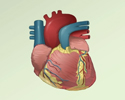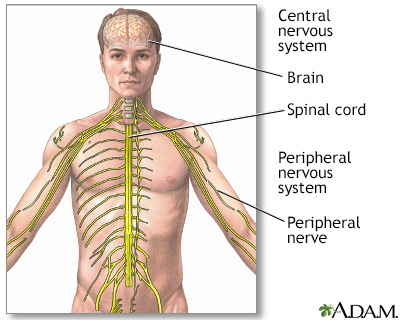Friedreich ataxia
Friedreich ataxia is a rare disease passed down through families (inherited). It affects the muscles and heart.
Causes
Friedreich ataxia is caused by a defect in a gene called frataxin (FXN). Changes in this gene cause the body to make too much of a part of DNA called trinucleotide repeat (GAA). Normally, the body contains about 8 to 30 copies of GAA. People with Friedreich ataxia have as many as 1,000 copies. The more copies of GAA a person has, the earlier in life the disease starts and the faster it gets worse.
Friedreich ataxia is an autosomal recessive genetic disorder. This means you must get a copy of the defective gene from both your mother and father.
Autosomal recessive
Autosomal recessive is one of several ways that a genetic trait, disorder, or disease can be passed down through families. An autosomal recessive dis...

Symptoms
Symptoms are caused by the wearing away of structures in areas of the brain and spinal cord that control coordination, muscle movement, and other functions. Symptoms most often begin before puberty. Symptoms may include:
- Abnormal speech
- Changes in vision, particularly color vision
- Decrease in ability to feel vibrations in lower limbs
- Foot problems, such as hammer toe and high arches
Hammer toe
Hammer toe is a deformity of the toe. The toe moves into a claw-like position. The end of the toe is bent downward.
 ImageRead Article Now Book Mark Article
ImageRead Article Now Book Mark ArticleHigh arches
High arch is a foot arch that is raised more than normal. The arch runs from the toes to the heel on the bottom of the foot. It is also called pes ...
Read Article Now Book Mark Article - Hearing loss, this occurs in about 10% of people
- Jerky eye movements
Jerky eye movements
Nystagmus is a term to describe uncontrollable movements of the eyes that may be:Side to side (horizontal nystagmus)Up and down (vertical nystagmus)R...
 ImageRead Article Now Book Mark Article
ImageRead Article Now Book Mark Article - Loss of coordination and balance, which leads to frequent falls
Loss of coordination
Uncoordinated movement is due to a muscle control problem that causes an inability to coordinate movements. It leads to a jerky, unsteady, to-and-fr...
 ImageRead Article Now Book Mark Article
ImageRead Article Now Book Mark Article - Muscle weakness
Muscle weakness
Weakness is reduced strength in one or more muscles.
 ImageRead Article Now Book Mark Article
ImageRead Article Now Book Mark Article - No reflexes in the legs
- Unsteady gait and uncoordinated movements (ataxia), which gets worse with time
Unsteady gait
Walking abnormalities can be caused by many different types of problems. Problems with the joints, (such as arthritis), bones (such as deformities),...
 ImageRead Article Now Book Mark Article
ImageRead Article Now Book Mark ArticleAtaxia
Uncoordinated movement is due to a muscle control problem that causes an inability to coordinate movements. It leads to a jerky, unsteady, to-and-fr...
 ImageRead Article Now Book Mark Article
ImageRead Article Now Book Mark Article
Muscle problems lead to changes in the spine. This may result in scoliosis or kyphoscoliosis.
Scoliosis
Scoliosis is an abnormal curving of the spine. Your spine is your backbone. It runs straight down your back. Everyone's spine naturally curves a b...

Kyphoscoliosis
Scoliosis is an abnormal curving of the spine. Your spine is your backbone. It runs straight down your back. Everyone's spine naturally curves a b...

Heart disease commonly develops and may lead to heart failure. Heart failure or dysrhythmias that do not respond to treatment may result in death. Diabetes may develop in later stages of the disease.
Heart disease
Coronary heart disease is a narrowing of the blood vessels that supply blood and oxygen to the heart. Coronary heart disease (CHD) is also called co...

Heart failure
Heart failure is a condition in which the heart is no longer able to pump oxygen-rich blood to the rest of the body efficiently. This causes symptom...

Dysrhythmias
An arrhythmia is a disorder of the heart rate (pulse) or heart rhythm. The heart can beat too fast (tachycardia), too slow (bradycardia), or irregul...

Diabetes
Diabetes is a long-term (chronic) disease in which the body cannot regulate the amount of sugar in the blood.

Exams and Tests
The following tests may be done:
- ECG
ECG
An electrocardiogram (ECG) is a test that records the electrical activity of the heart.
 ImageRead Article Now Book Mark Article
ImageRead Article Now Book Mark Article - Electrophysiological studies
- Electromyography (EMG)
Electromyography
Electromyography (EMG) is a test that checks the health of the muscles and the nerves that control the muscles.
 ImageRead Article Now Book Mark Article
ImageRead Article Now Book Mark Article - Genetic testing
- Nerve conduction tests
Nerve conduction tests
Nerve conduction velocity (NCV) is a test to see how fast electrical signals move through a nerve. This test is done along with electromyography (EM...
 ImageRead Article Now Book Mark Article
ImageRead Article Now Book Mark Article - Muscle biopsy
Muscle biopsy
A muscle biopsy is the removal of a small piece of muscle tissue for examination.
 ImageRead Article Now Book Mark Article
ImageRead Article Now Book Mark Article - X-ray, CT scan, or MRI of the head
X-ray
X-rays are a type of electromagnetic radiation, just like visible light. An x-ray machine sends individual x-ray waves through the body. The images...
 ImageRead Article Now Book Mark Article
ImageRead Article Now Book Mark ArticleCT
A computed tomography (CT) scan is an imaging method that uses x-rays to create pictures of cross-sections of the body. Related tests include:Abdomin...
 ImageRead Article Now Book Mark Article
ImageRead Article Now Book Mark ArticleMRI of the head
A head MRI (magnetic resonance imaging) is an imaging test that uses powerful magnets and radio waves to create pictures of the brain and surrounding...
 ImageRead Article Now Book Mark Article
ImageRead Article Now Book Mark Article - X-ray of the chest
X-ray of the chest
A chest x-ray is an x-ray of the chest, lungs, heart, large arteries, ribs, and diaphragm.
 ImageRead Article Now Book Mark Article
ImageRead Article Now Book Mark Article - X-ray of the spine
X-ray of the spine
A thoracic spine x-ray is an x-ray of the 12 chest (thoracic) bones (vertebrae) of the spine. The vertebrae are separated by flat pads of cartilage ...
 ImageRead Article Now Book Mark Article
ImageRead Article Now Book Mark Article
Blood sugar (glucose) tests may show diabetes or glucose intolerance. An eye exam may show damage to the optic nerve, which most often occurs without symptoms.
Treatment
Treatment for Friedreich ataxia includes:
- Counseling
- Speech therapy
- Physical therapy
- Walking aids or wheelchairs
A new medicine, omaveloxolone (Skyclarys), was approved by FDA in 2023 to slow disease progression. Orthopedic devices (braces) may be needed for scoliosis and foot problems. Treating heart disease and diabetes help people live longer and improve their quality of life.
Outlook (Prognosis)
Friedreich ataxia slowly gets worse and causes problems doing everyday activities. Most people need to use a wheelchair within 15 years of the disease's start. The disease may lead to early death.
Possible Complications
Complications may include:
- Diabetes
- Heart failure or heart disease
- Loss of ability to move around
When to Contact a Medical Professional
Contact your health care provider if symptoms of Friedreich ataxia occur, especially if there is a family history of the disorder.
Prevention
People with a family history of Friedreich ataxia who intend to have children may want to consider genetic screening to determine their risk.
Reviewed By
Anna C. Edens Hurst, MD, MS, Associate Professor in Medical Genetics, The University of Alabama at Birmingham, Birmingham, AL. Review provided by VeriMed Healthcare Network. Also reviewed by David C. Dugdale, MD, Medical Director, Brenda Conaway, Editorial Director, and the A.D.A.M. Editorial team.
Mink JW. Movement disorders. In: Kliegman RM, St. Geme JW, Blum NJ, et al, eds. Nelson Textbook of Pediatrics. 22nd ed. Philadelphia, PA: Elsevier; 2025:chap 637.
Okun MS, Ostrem JL. Other movement disorders. In: Goldman L, Cooney KA, eds. Goldman-Cecil Medicine. 27th ed. Philadelphia, PA: Elsevier; 2024:chap 379.

 All rights reserved.
All rights reserved.